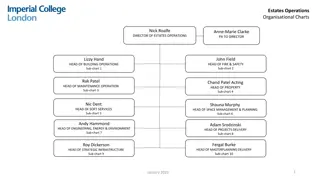Domain-Agnostic Information Model for Vehicle Data Transformation
The push towards a domain-agnostic information model from a vehicle-centric data approach is explored due to emerging industry requirements. COVESA projects like AUTOSAR Vehicle API and EV charging necessitate a shift. The proposal introduces the Hierarchical Information Model (HIM) to organize data
1 views • 10 slides
Prioritizing Clinically Important Outcomes Using Hierarchical Win Ratio
Clinical trials often use composite outcomes, but conventional analysis methods have limitations in accurately reflecting clinical reality. Hierarchical outcomes offer flexibility by defining a hierarchy of events based on importance. Analyzing trials using hierarchical outcomes involves comparing p
7 views • 20 slides
The Diocesan Organisation
In the depicted Diocesan organization chart, Jonathan Wood serves as the Diocesan Secretary/CEO, leading the Senior Leadership Team consisting of various directors overseeing strategy implementation, ministry and mission, church revitalization, people and engagement, education, communications, and f
0 views • 13 slides
Efficacy and Safety of Ferric Carboxymaltose for Heart Failure with Iron Deficiency
Iron deficiency is prevalent in heart failure patients with reduced ejection fraction and is linked to poor outcomes. The HEART-FID trial investigates the impact of intravenous ferric carboxymaltose (FCM) on all-cause mortality, heart failure hospitalizations, and exercise capacity in chronic HFrEF
1 views • 17 slides
Administration: Ancient, Medieval and colonial
The evolution of administration in India traces back to the earliest monarchial systems in the Vedic period, progressing through texts like Arthshastra and principles of hierarchy. Ancient administrators emphasized decentralization and hierarchical structures. Arthshastra acted as a manual for admin
3 views • 17 slides
HSE & Security Organization Structure Overview
This document outlines the hierarchical structure of the HSE and Security organization as of October 1, 2023. It includes details on key personnel, regions of responsibility, and specific roles within the organization. The organization's chart provides a comprehensive view of the leadership team and
7 views • 4 slides
Don’t Confuse More Data with Better Insights — How to Streamline Your Marketing Dashboards
In today's data-driven world, more data doesn't always mean better insights. Learn how to streamline your marketing dashboards by focusing on core KPIs, ensuring data accuracy, and adopting a user-centric design. Discover practical tips for prioritizing metrics, implementing hierarchical layouts, an
3 views • 8 slides
Clustering Algorithms: K-means and Hierarchical Clustering
Explore the concepts of clustering and retrieval in machine learning, focusing on K-means and Hierarchical Clustering algorithms. Learn how clustering assigns labels to data points based on similarities, facilitates data organization without labels, and enables trend discovery and predictions throug
1 views • 48 slides
The Evolution of Finance Function Structures in the Digital Era
Explore the changing landscape of finance function structures in the digital age, from hierarchical shapes to shared services and outsourcing. Learn about the importance of organizational structure and different types of structures like entrepreneurial, functional, divisional, and matrix. Dive into
3 views • 22 slides
Organisational Structure of Estates Operations Team
The organisational chart depicts the hierarchical structure of the Estates Operations team, led by the Director of Estates Operations. It showcases the various heads and managers responsible for building operations, maintenance, soft services, space management, projects delivery, engineering, energy
0 views • 20 slides
Aristotle's Justification of Hierarchy and Republican Aspects of Citizenship
Aristotle's concept of citizenship involves a hierarchical structure where ruling and being ruled in turn is essential. He justifies this hierarchy by emphasizing the advantageous nature of ruling and being ruled. However, his views on citizenship in Greek city-states were limited to adult males, hi
4 views • 6 slides
Major Formation Types of the World by Dr. Zaryab Khalid - BS Botany Semester 7
This presentation by Dr. Zaryab Khalid explores the major formation types of the world in the field of community ecology. It delves into the classification of natural and cultural vegetations, the concept of formation classes and subclasses, and details the six natural formation classes along with e
3 views • 7 slides
Overview of Distributed Availability Groups by Marcelo Gonçalves Adade
Marcelo Gonçalves Adade, a Lead Database Consultant at The Pythian Group, provides insights on Distributed Availability Groups (DAGs) focusing on deployment, monitoring, scenarios, advantages, and key factors. He emphasizes the importance of proper configuration, management within SQL Server, and m
1 views • 14 slides
Classical Approach in Business Management
The Classical Approach in Business Management focused on improving efficiency, decreasing costs, and increasing profits by adopting scientific principles. It emphasized planning, organizing, and controlling as key functions of management. The hierarchical organizational structure with a pyramid shap
5 views • 34 slides
Directed Acyclic Graphs (DAGs) for Causal Inference
Directed Acyclic Graphs (DAGs) play a crucial role in documenting causal assumptions and guiding variable selection in epidemiological models. They inform us about causal relationships between variables and help answer complex questions related to causality. DAGs must meet specific requirements like
1 views • 63 slides
Design and Evaluation of Hierarchical Rings with Deflection Routing
This research explores the implementation of Hierarchical Rings with Deflection (HiRD) routing as a solution to the performance and energy inefficiencies found in traditional hierarchical ring designs. HiRD guarantees livelock freedom and efficient delivery while simplifying the network structure by
0 views • 52 slides
Creating Second Hierarchical Data Table in Windchill PDMLink
Learn how to set up a second hierarchical data table in Windchill PDMLink by selecting rows from the first table to view and interact with related objects in a structured manner. The process involves customization and user actions within the tables to manage parts and documents efficiently.
0 views • 8 slides
Hierarchical Attention Transfer Network for Cross-domain Sentiment Classification
A study conducted by Zheng Li, Ying Wei, Yu Zhang, and Qiang Yang from the Hong Kong University of Science and Technology on utilizing a Hierarchical Attention Transfer Network for Cross-domain Sentiment Classification. The research focuses on sentiment classification testing data of books, training
0 views • 28 slides
Optimizing Operator Fusion Plans for Large-Scale Machine Learning in SystemML
The research focuses on optimizing fusion plans for large-scale machine learning in SystemML. It discusses the motivation behind fusion opportunities, the need for optimizing fusion plans, and system architecture considerations. The study emphasizes the challenges in heuristic fusion planning for co
0 views • 17 slides
Data Summarization with Hierarchical Taxonomy: Motivations and Examples
The research discusses the use of Hierarchical DAGs in summarizing data with a focus on disease ontology and animal diseases. It explores how general concepts can summarize specific items and their relationships. The study also presents motivated examples of popular papers summarization in SIGMOD, s
0 views • 27 slides
Classifying Entities into an Incomplete Ontology: Exploratory EM Approach
The research discusses methods for hierarchical classification of entities into incomplete ontologies. It explores the challenges of evolving web-scale datasets and the need for classifying entities in an incomplete ontology structure. The Hierarchical Exploratory EM model is detailed, providing ins
0 views • 27 slides
Denoising-Oriented Deep Hierarchical Reinforcement Learning for Next-basket Recommendation
This research paper presents a novel approach, HRL4Ba, for Next-basket Recommendation (NBR) by addressing the challenge of guiding recommendations based on historical baskets that may contain noise products. The proposed Hierarchical Reinforcement Learning framework incorporates dynamic context mode
0 views • 16 slides
Hierarchical Semi-Supervised Classification with Incomplete Class Hierarchies
This research explores the challenges and solutions in semi-supervised entity classification within incomplete class hierarchies. It addresses issues related to food, animals, vegetables, mammals, reptiles, and fruits, presenting an optimized divide-and-conquer strategy. The goal is to achieve semi-
1 views • 18 slides
Building Hierarchical Ratings Model without Alternatives Listed
Learn to build a hierarchical ratings model with 4 criteria, including subcriteria for Comfort, using a step-by-step approach. Explore how to select covering criteria, create performance scales, add and rate alternatives, and prioritize rating intensities for effective evaluation. Streamline your ra
0 views • 12 slides
Efficient and Effective Duplicate Detection in Hierarchical Data
This study explores the efficient and effective detection of duplicates in hierarchical data, focusing on fuzzy duplicates and hierarchical relationships in XML. It discusses the current and proposed systems, including the use of Bayesian networks for similarity computations. The methods involve vec
0 views • 25 slides
Graph Summarization on Hierarchical DAGs
Explore top-k graph summarization techniques on Hierarchical Directed Acyclic Graphs (DAGs) like Disease Ontology, ImageNet, and Wikipedia Categories. Understand motivations for summarization, related works, and the kDAG-Problem. Discover algorithms, experiments, and conclusions for efficient graph
0 views • 38 slides
Epidemiology Concepts in Research and Analysis
Exploring important epidemiology concepts such as exposure, outcome, risk, confounders, effect measures, and more, this content delves into variable selection using Directed Acyclic Graphs (DAGs) for causal inference in research and analysis. Understanding these concepts is crucial for conducting ro
0 views • 37 slides
Directed Acyclic Graphs (DAGs)
Explore the significance of Directed Acyclic Graphs (DAGs) in comprehending data structures, addressing issues like bias, loss to follow up, and missing data impacts in studies. Gain insights into key concepts, nodes, arrows, causality, associations, causal structures, and the role of confounders. E
0 views • 26 slides
Directed Acyclic Graphs (DAGs) in Epidemiology
Exploring the significance of Directed Acyclic Graphs (DAGs) in pharmacoepidemiology, this content delves into the challenges faced in analyzing observational data and the benefits of DAGs in identifying confounders, mediators, and colliders. The conclusion emphasizes the importance of transparent r
0 views • 58 slides
Hierarchical vs. Non-Hierarchical Models in Computer Graphics
Dive into the concepts of hierarchical and non-hierarchical modeling in computer graphics. Explore how hierarchical models represent complex objects with explicit sub-part dependencies, while non-hierarchical models treat objects independently. Understand the benefits and challenges of each approach
0 views • 30 slides
Utilizing Bayesian Hierarchical Model for Clinical Trial Quality Design
Explore how a Bayesian Hierarchical Model can be leveraged to design quality into clinical trials and ensure compliance with ICH E6 R2 Quality Tolerance Limits. Learn about the Risk-Based approach, Quality Tolerance Limits methodology, and the application of Bayesian modeling for early phase studies
0 views • 14 slides
Overview of DAGs in Causal Inference
Understanding Directed Acyclic Graphs (DAGs) in causal inference is crucial for guiding research questions and analyzing causal relationships. This overview covers the basics of DAGs, their requirements, and applications in analyzing causal assumptions. Dive into the world of DAGs to enhance your re
0 views • 28 slides
Hierarchical Body Modeling in OpenGL Homework 3
Explore the concepts of hierarchical body modeling in OpenGL Homework 3 by creating body part hierarchies, recording transformation matrices, and understanding the hierarchy structures. The homework focuses on building hierarchies for body parts like thighs and shanks, applying transformations, and
0 views • 23 slides
Machine Learning Approach for Hierarchical Classification of Transposable Elements
This study presents a machine learning approach for the hierarchical classification of transposable elements (TEs) based on pre-annotated DNA sequences. The research includes data collection, feature extraction using k-mers, and classification approaches. Proper categorization of TEs is crucial for
0 views • 18 slides
Risk Adjustment Hierarchical Condition Categories
The Centers for Medicare and Medicaid Services (CMS) introduced the Hierarchical Condition Categories (HCC) coding payment model in 2004 for Medicare Advantage and Prescription Drug Plans. This model adjusts payments based on enrollees' demographics and health status, using 70 HCC categories correla
0 views • 19 slides
Particle-laden Turbulence in a Radiation Environment: Efficient Linear Solver
This research focuses on developing a parallel linear solver using hierarchical matrix techniques to solve particle-laden turbulence problems in radiation environments. Motivations include tackling large linear systems from various applications and leveraging heterogeneous machine architectures. The
0 views • 22 slides
Improved Hierarchical Word Sequence Language Model Using Word Association
This research presents an enhanced hierarchical word sequence language model leveraging word association techniques. It explores the motivation behind the model, smoothing techniques for data sparsity, and the basic idea of the proposed approach, focusing on patterns and word generation. The propose
0 views • 21 slides
Hierarchical Sensitivity
Sensitivity studies analyze how the priorities of alternatives change as criteria priorities vary. Explore graphical sensitivity techniques and interpretations to make informed decisions in hierarchical structures.
0 views • 10 slides
Applications of Depth-First Search in Graph Topology
Discover the significance of graph topology and the applications of Depth-First Search (DFS) in laying out data for interpretation. Learn about topological sorting, Directed Acyclic Graphs (DAGs), and the correctness of topological sort.
0 views • 17 slides
Hierarchical Clustering
- Hierarchical clustering is a versatile technique in data mining that creates a hierarchical decomposition of objects based on similarity or distance measures. This clustering method offers insights into data relationships through dendrograms, allowing for the identification of outliers and the exp
0 views • 36 slides







































